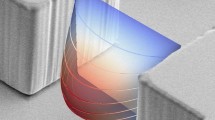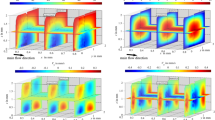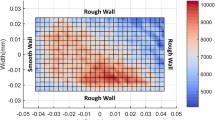Abstract
A simultaneous measurement technique for the velocity and pH distribution was developed by using a confocal microscope and a 3CCD color camera for investigations of a chemical reacting flow field in a microchannel. Micron-resolution particle image velocimetry and laser induced fluorescence were utilized for the velocity and pH measurement, respectively. The present study employed fluorescent particles with 1 μm diameter and Fluorescein sodium salt whose fluorescent intensity increases with an increase in pH value over the range of pH 5.0–9.0. The advantages of the present system are to separate the fluorescence of particles from that of dye by using the 3CCD color camera and to provide the depth resolution of 5.0 μm by the confocal microscope. The measurement uncertainties of the velocity and pH measurements were estimated to be 5.5 μm/s and pH 0.23, respectively. Two aqueous solutions at different pH values were introduced into a T-shaped microchannel. The mixing process in the junction area was investigated by the present technique, and the effect of the chemical reaction on the pH gradient was discussed by a comparison between the proton concentration profiles obtained from the experimental pH distribution and those calculated from the measured velocity data. For the chemical reacting flow with the buffering action, the profiles from the numerical simulation showed smaller gradients compared with those from the experiments, because the production or extinction of protons was yielded by the chemical reaction. Furthermore, the convection of protons was evaluated from the velocity and pH distribution and compared with the diffusion. It is found that the ratio between the diffusion and convection is an important factor to investigate the mixing process in the microfluidic device with chemical reactions.












Similar content being viewed by others
References
Auroux PA, Iossifidis D, Reyes DR, Manz A (2002) Micro total analysis systems. 2. Analytical standard operations and applications. Anal Chem 74:2637–2652
Chen JM, Horng TL, Tan WY (2006) Analysis and measurements of mixing in pressure-driven microchannel flow. Microfluid Nanofluid 2:455–469
Choi J, Hirota N, Terazima M (2001) A pH-jump reaction studied by the transient grating method: photodissociation of o-nitrobenzaldehyde. J Phys Chem A 105:12–18
Coppeta J, Rogers C (1998) Dual emission laser induced fluorescence for direct planar scalar behavior measurements. Exp Fluids 25:1–15
Fukada H, Takahashi K (1998) Enthalpy and heat capacity changes for the proton dissociation of various buffer components in 0.1 M potassium chloride. Proteins Struct Funct Genet 33:159–166
Ismagilov RF, Stroock AD, Kenis PJA, Whitesides G, Stone HA (2000) Experimental and theoretical scaling laws for transverse diffusive broadening in two-phase laminar flow in microchannels. Appl Phys Lett 76:2376–2378
Kamholz AE, Yager P (2001) Theoretical analysis of molecular diffusion in pressure-driven laminar flow in microfluidic channels. Biophys J 80:155–160
Kamholz AE, Weigl BH, Finlayson BA, Yager P (1999) Quantitative analysis of molecular interaction in a microfluidic channel: the T-sensor. Anal Chem 71:5340–5347
Keij JF, Steinkamp JA (1998) Flow cytometric characterization and classification of multiple dual-color fluorescent microspheres using fluorescence lifetime. Cytometry 33:318–323
Knight JB, Vishwanath A, Brody JP, Austin RH (1998) Hydrodynamic focusing on a silicon chip: Mixing nanoliters in microseconds. Phys Rev Lett 80:3863–3866
Lam YC, Chen X, Yang C (2005) Depthwise averaging approach to cross-stream mixing in a pressure-driven microchannel flow. Microfluid Nanofluid 1:218–226
Lima R, Wada S, Tsubota K, Yamaguchi T (2006) Confocal micro-PIV measurements of three-dimensional profiles of cell suspension flow in a square microchannel. Meas Sci Technol 17:797–808
Meinhart CD, Werely ST, Gray MHB (2000) Volume illumination for two-dimensional particle image velocimetry. Meas Sci Technol 17:809–814
Park JS, Kihm KD (2006) Use of confocal laser scanning microscopy (CLSM) for depthwise resolved microscale-particle image velocimetry (μ-PIV). Opt Lasers Eng 44:208–223
Park JS, Choi CK, Kihm KD (2004) Optically sliced micro-PIV using confocal laser scanning microscopy (CLSM). Exp Fluids 37:105–119
Patankar SV (1980) Numerical heat transfer and fluid flow. McGraw-Hill, New York
Reyes DR, Iossifidis D, Auroux PA, Manz A (2002) Micro total analysis systems. 1. Introduction, theory, and technology. Anal Chem 74:2623–2636
Sandison DR, Webb WW (1994) Background rejection and signal-to-noise optimization in confocal and alternative fluorescence microscopes. Appl Opt 33:603–615
Santiago JG, Wereley ST, Meinhart CD, Beebe DJ, Adrian RJ (1998) A particle image velocimetry system for microfluidics. Exp Fluids 25:316–319
Sato Y, Irisawa G, Ishizuka M, Hishida K, Maeda M (2003) Visualization of convective mixing in microchannel by fluorescence imaging. Meas Sci Technol 14:114–121
Shinohara K, Sugii Y, Okamoto K, Madarame H, Hibara A, Tokeshi M, Kitamori T (2004) Measurement of pH field of chemically reacting flow in microfluidic devices by laser-induced fluorescence. Meas Sci Technol 15:955–960
Shinohara K, Sugii Y, Hibara M, Tokeshi M, Kitamori T, Okamoto K (2005) Rapid proton diffusion in microfluidic devices by means of micro-LIF technique. Exp Fluids 38:117–122
Sinton D (2004) Microscale flow visualization. Microfluid Nanofluid 1:2–21
Walker DA (1987) A fluorescence technique for measurement of concentration in mixing fluids. J Phys 20:217–224
Westerweel J (1997) Fundamentals of digital particle image velocimetry. Meas Sci Technol 8:1397–1392
White FM (2006) Viscous fluid flow, 3rd edn. McGraw-Hill, New York
Xia Y, Whitesides GM (1998) Soft lithography. Annu Rev Mater Sci 28:153–184
Acknowledgments
This work was subsidized by R&D for practical use of university-based technology from matching government and private funds, the Grant-in-Aid for Scientific Research (No. 15206024) and the 21st century center of excellence for “System Design: Paradigm Shift from Intelligence to Life” from the Ministry of Education, Culture, Sports, Science and Technology in Japan.
Author information
Authors and Affiliations
Corresponding author
Rights and permissions
About this article
Cite this article
Ichiyanagi, M., Sato, Y. & Hishida, K. Optically sliced measurement of velocity and pH distribution in microchannel. Exp Fluids 43, 425–435 (2007). https://doi.org/10.1007/s00348-007-0326-y
Received:
Revised:
Accepted:
Published:
Issue Date:
DOI: https://doi.org/10.1007/s00348-007-0326-y




